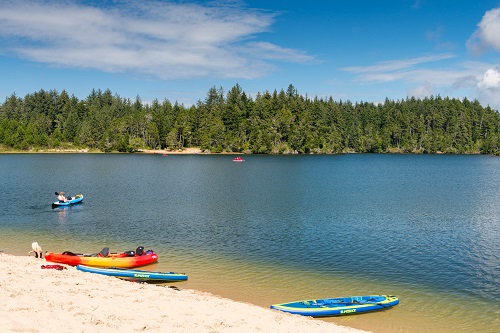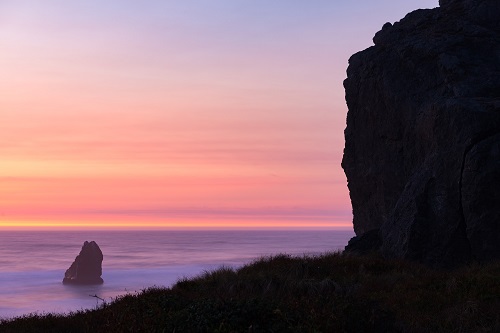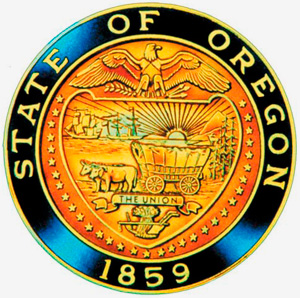Oregon Almanac: Nut, State to Shoes, Oldest
Page Content
 Cleawox Lake at Honeyman State Park. (Oregon Scenic Images collection)
Cleawox Lake at Honeyman State Park. (Oregon Scenic Images collection)
Nut, State
The hazelnut, or filbert, (Corylus avellana) was named the state nut by the 1989 Legislature. Oregon grows 99% of the entire U.S. commercial crop. The Oregon hazelnut, unlike wild varieties, grows on single-trunked trees up to 40 feet tall. Adding a unique texture and flavor to recipes and products, hazelnuts are preferred by chefs, bakers, confectioners, food manufacturers and homemakers worldwide.
Outdoor Pageant, State
The 2011 Legislature designated Pendleton’s Happy Canyon Indian Pageant and Wild West Show the official outdoor pageant. Presented annually since 1911, local area tribal members worked up the depiction of native village life seen in the present-day script. Acted by a cast of members of local area tribes and local community volunteer actors, the show moves from a depiction of early tribal culture into historic and cultural events such as the coming of Lewis and Clark and the settling of the American West. A live orchestra of Pacific Northwest professional musicians accompanies the show.
 Rescue dogs and cats became Oregon’s official state pet in 2023.
Rescue dogs and cats became Oregon’s official state pet in 2023. Parks, State
259 parks totaling over 113,000 acres; day use attendance of 50 million per year; 8 scenic and 4 regional trails; 52 campgrounds
Pet, State
Rescue cats and dogs were named Oregon's official state pet by the Legislature in 2023. Veterinarians and pet owners testified in favor of the resolution.
Physical Dimensions
United States rank in total area: 9th
Land area: 95,988 square miles
Water area: 2,391 square miles
Total area: 98,379 square miles
Coastline: 362 miles
Pie, State
Marionberry pie was designated Oregon’s official pie by the 2017 Legislature. The Marionberry was an Oregon State University blackberry breeding program’s 1950s cross between the “Chehalem” and “Olallieberry.” It was named for Marion County where extensive testing found it to have a greater yield and earlier harvest season than the more well-known Boysenberry.
Poet Laureate
 Oregon has 363 miles of coastline. Shown above is a sunset at the coast near Kissing Rock and Hunter Creek in Curry County. (Oregon Scenic Images collection)
Oregon has 363 miles of coastline. Shown above is a sunset at the coast near Kissing Rock and Hunter Creek in Curry County. (Oregon Scenic Images collection)
In 2024, Governor Tina Kotek named Ellen Waterston Oregon’s 11th Poet Laureate. A New Englander who moved to the ranching west, much of Waterston’s prose and poetry is inspired by the remote reaches of southeastern Oregon’s Outback. Her memoir, “Then There Was No Mountain” is a Foreward and WILLA finalist. Waterson has published four poetry titles and is winner of the Obsidian Prize in Poetry and two-time winner of the WILLA Award in Poetry. She also founded the for-profit Writing Ranch and two literary nonprofits, The Nature of Words and the Waterson Desert Writing Prize. Waterson received her B.A. from Harvard University and M.A. in Archeology from University of Madagascar. She was recognized with an honorary PhD in Humane Letters from OSU-Cascades in 2007. In 2024 she received the Literary Arts Holdbrook Literary Legacy Award and Soapstone’s Bread and Roses Award.
Population
Oregon is ranked 39th in population density with 42 inhabitants per square mile. (2023)
1850 = 12,093
1860 = 52,465
1870 = 90,923
1880 = 174,768
1890 = 317,704
1900 = 413,536
1910 = 672,765
1920 = 783,389
1930 = 953,786
1940 = 1,089,684
1950 = 1,521,341
1960 = 1,768,687
1970 = 2,091,533
1980 = 2,633,321
1990 = 2,842,321
2000 = 3,421,399
2010 = 3,837,300
2020 = 4,237, 256
2023 = 4,296,646
Precipitation
Record 24-hour maximum rainfall: 14.3" on November 6, 2006, at Lees Camp in the Tillamook County Coast Range
Average yearly precipitation at Salem: 40.08"
Record 24-hour snowfall: 47" on January 9, 1980, at the Hood River Experimental Station
Record snow depth: 252" in 1950 at Crater Lake National Park Headquarters
Reservoir, Longest
Lake Owyhee - 53 miles
Rivers, Longest
Columbia River: 1,249 miles;
Snake River: 1,040 miles
Rivers, Entirely in the State of Oregon:
John Day River: 284 miles;
Deschutes River: 252 miles
Rock, State
The thunder egg (geode) was named the Oregon state rock by the 1965 Legislature after rockhounds throughout Oregon voted it as their favorite rock. Thunder eggs range in diameter from less than one inch to over four feet. Nondescript on the outside, they reveal exquisite designs in a wide range of colors when cut and polished. They are found chiefly in Crook, Jefferson, Malheur, Wasco and Wheeler Counties.
Schools, Public
Education Service Districts: 19
Schools: 1451
School Districts: 208
Student population (2023–2024): 547,424
Seal, State
 The state seal bears the inscription "The Union."
Enlarge image.
The state seal bears the inscription "The Union."
Enlarge image. On September 17, 1857, the Constitutional Convention adopted a resolution that authorized the U.S. president to appoint a committee of three—Benjamin F. Burch, L. F. Grover and James K. Kelly—to report on a proper seal for the State of Oregon. Harvey Gordon created a draft, to which the committee recommended additions. The state seal consists of a shield, supported by 33 stars and divided by a ribbon with the inscription “The Union.” Above the ribbon are the mountains and forests of Oregon, an elk with branching antlers, a covered wagon and ox team, the Pacific Ocean with setting sun, a departing British man-of-war ship signifying the departure of British influence in the region, and an arriving American merchant ship, signifying the rise of American power. Below the ribbon is a quartering with a sheaf of wheat, plow and pickax, representing Oregon’s mining and agricultural resources. The crest is the American Eagle and around the perimeter of the seal is the legend “State of Oregon 1859.”
Seashell, State
 Hairy triton with snail inside. Photo courtesy Oregon Department of Fish and Wildlife.
Hairy triton with snail inside. Photo courtesy Oregon Department of Fish and Wildlife.In 1848, conchologist John Howard Redfield named the
Fusitriton oregonensis after the Oregon Territory. Commonly called the Oregon Hairy Triton, the shell is one of the largest found in the state, reaching lengths up to five inches. The shells are found from Alaska to California and wash up on the Oregon coast at high tide. The Legislature designated it the state shell in 1989.
Shoes, Oldest
Sandals that are 9,300 years old, made of sagebrush and bark, were found at Fort Rock Cave in Central Oregon in 1938 by archaeologist Luther Cressman.